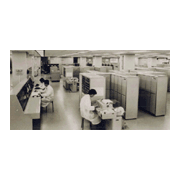The DIPS Project began in 1967, and practical development of the DIPS-1 began in the latter half of 1968, following the DIPS-0 Project. The goal of the project was "to complete both the hardware and software of a large standard information processing system for data communications by March 1973, and to ensure that the system could rival the best foreign machines in terms of system performance and performance/cost ratio". The project was started in April 1969 by a joint research organization comprised of NEC, Hitachi, and Fujitsu under the leadership of the Electrical Communication Laboratories of Nippon Telegraph and Telephone Public Corporation.
The DIPS-1 prototype was finished in October 1971, and in March 1972, an on-site test machine (DIPS-1F) was installed in the Tokyo Shiba subscriber exchange office. This machine was on the cutting-edge of technology, with a system combining 4 multiprocessors, local memory and paging, use of NMOS-ICs, and a main memory with 16 MB. It also embodied so-called multi-vendor hardware, where each of the three companies could take charge of hardware manufacturing.
To achieve software uniformity for the DIPS-1, efforts were made to standardize the architecture (including machine language) and to standardize the I/O interfaces for ensuring peripheral device compatibility. Later the machine was adopted in scientific/engineering computation services (DEMOS-E began service in November 1972) and commercial systems such as the Chiba Bank system.


